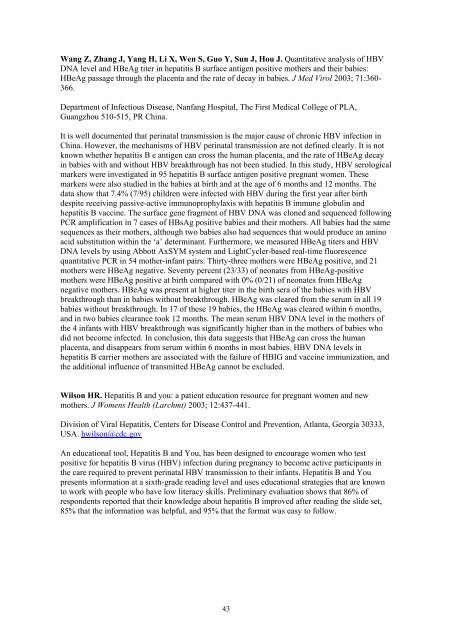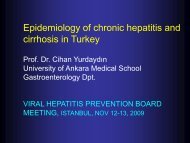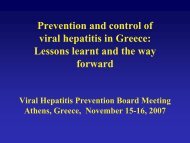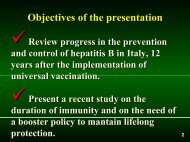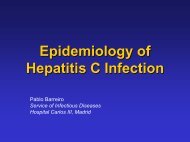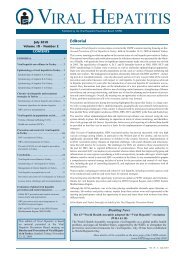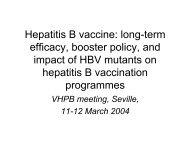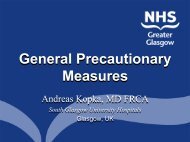Vryheid RE, Yu ES, Mehta KM, McGhee J. The decl<strong>in</strong><strong>in</strong>g prevalence <strong>of</strong> <strong>hepatitis</strong> B <strong>virus</strong><strong>in</strong>fection among Asian <strong>and</strong> Pacific Isl<strong>and</strong>er children. Asian Am Pac Isl J Health 2001; 9:162-178.This article provides a review <strong>of</strong> the literature on the decl<strong>in</strong>e <strong>of</strong> <strong>hepatitis</strong> B <strong>virus</strong> (HBV) <strong>in</strong>fection<strong>in</strong> Asian <strong>and</strong> Pacific nations hav<strong>in</strong>g universal <strong>hepatitis</strong> B immunization programs. Papers on theepidemiology <strong>of</strong> HBV <strong>in</strong>fection <strong>and</strong> <strong>hepatitis</strong> B immunization programs <strong>in</strong> Asian <strong>and</strong> Pacificnations were located by search<strong>in</strong>g MEDLINE <strong>and</strong> libraries for publications <strong>in</strong> English, <strong>and</strong> bycontact<strong>in</strong>g <strong>hepatitis</strong> B experts. High endemicity for HBV <strong>in</strong> Asian <strong>and</strong> Pacific nations was partlycaused by a cycle <strong>of</strong> high <strong>in</strong>fectiousness, <strong>per<strong>in</strong>atal</strong> <strong>transmission</strong>, <strong>and</strong> chronic <strong>in</strong>fection from earlyages. Higher prevalence <strong>of</strong> <strong>in</strong>fection has been found <strong>in</strong> men, some families, communities, <strong>and</strong>ethnic groups, <strong>and</strong> <strong>in</strong> people with high risk behaviors <strong>and</strong> situations, such as attend<strong>in</strong>g day care,gett<strong>in</strong>g <strong>in</strong>jections, or shar<strong>in</strong>g personal items. Incidence <strong>of</strong> acquisition <strong>of</strong> <strong>in</strong>fection is about 2%-5%per year. Prevalence <strong>of</strong> HBV <strong>in</strong>fection was decl<strong>in</strong><strong>in</strong>g <strong>in</strong> some nations before commenc<strong>in</strong>g <strong>hepatitis</strong>B immunization programs, probably because <strong>of</strong> improvements <strong>in</strong> medical practices <strong>and</strong> liv<strong>in</strong>gconditions. Twenty-seven <strong>of</strong> 34 Pacific <strong>and</strong> East <strong>and</strong> Southeast Asian nations have atta<strong>in</strong>ed > 70%<strong>hepatitis</strong> B vacc<strong>in</strong>ation coverage <strong>in</strong> <strong>in</strong>fants, <strong>and</strong> twelve have documented reduc<strong>in</strong>g <strong>in</strong>fection orliver cancer to fractions <strong>of</strong> their former rates. But the immunization programs may be caus<strong>in</strong>gnatural selection <strong>of</strong> mutant <strong>hepatitis</strong> B <strong>virus</strong>es, necessitat<strong>in</strong>g study <strong>of</strong> the mutants, <strong>and</strong> modification<strong>of</strong> serological tests <strong>and</strong> vacc<strong>in</strong>es. Practical implications for U.S. health pr<strong>of</strong>essionals are:<strong>in</strong>creas<strong>in</strong>g HBV screen<strong>in</strong>g <strong>and</strong> <strong>hepatitis</strong> B vacc<strong>in</strong>ation <strong>of</strong> adolescents <strong>and</strong> adults from Asian <strong>and</strong>Pacific nations can prevent many <strong>in</strong>fections <strong>and</strong> disease cases; most children com<strong>in</strong>g from highcoverage Asian <strong>and</strong> Pacific nations will be immune <strong>and</strong> few <strong>in</strong>fected; we can learn much fromthese successful programs; <strong>and</strong> we should still make efforts to immunize Asian <strong>and</strong> Pacificchildren <strong>in</strong> the United States, <strong>and</strong> help Asian <strong>and</strong> Pacific nations which do not yet have highlysuccessful <strong>hepatitis</strong> B immunization programs.Wang JS, Chen H, Zhu QR. Transformation <strong>of</strong> <strong>hepatitis</strong> B serologic markers <strong>in</strong> babies born to<strong>hepatitis</strong> B surface antigen positive mothers. World J Gastroenterol 2005; 11:3582-3585.The aim was to better underst<strong>and</strong> the cl<strong>in</strong>ical significance <strong>of</strong> <strong>hepatitis</strong> B serologic markers <strong>in</strong>babies born to <strong>hepatitis</strong> B surface antigen (HBsAg) positive mothers, the <strong>in</strong>cidence <strong>of</strong> maternalserologic markers <strong>of</strong> <strong>hepatitis</strong> B via placenta <strong>and</strong> its transformation <strong>in</strong> these babies were<strong>in</strong>vestigated. Mothers with positive HBsAg were selected <strong>in</strong> the third trimester <strong>of</strong> pregnancy. Theirbabies received immunoprophylaxis with <strong>hepatitis</strong> B immunoglobul<strong>in</strong> <strong>and</strong> <strong>hepatitis</strong> B vacc<strong>in</strong>e afterbirth, <strong>and</strong> were consecutively followed up for <strong>hepatitis</strong> B serologic markers <strong>and</strong> HBV DNA atbirth, mo 1, 4, 7, 12, <strong>and</strong> 24. Forty-two babies entered the study, <strong>in</strong>clud<strong>in</strong>g 16 born to <strong>hepatitis</strong> B eantigen (HBeAg)-positive HBsAg carrier mothers <strong>and</strong> 26 to HBeAg-negative HBsAg carriermothers. Apart from four babies born to HBeAg-positive carrier mothers <strong>and</strong> demonstratedpersistent positive HBeAg eventually became HBV carriers, all other babies developed anti-HBsbefore 12 mo <strong>of</strong> age. Among the other 12 babies born to HBeAg-positive carrier mothers, HBeAgwas detected <strong>in</strong> 7 at birth, <strong>in</strong> 4 at mo 1, <strong>and</strong> <strong>in</strong> none <strong>of</strong> them thereafter. No antibody response to thetransplacental HBeAg was detected. Among the babies born to HBeAg-negative carrier mothers,anti-HBe was detected 100% at birth <strong>and</strong> mo 1, <strong>in</strong> 88.5% at mo 4, <strong>in</strong> 46.2% at mo 7, <strong>in</strong> 4.2% at mo12 <strong>and</strong> none <strong>in</strong> mo 24. Among all the immunoprophylaxis-protected babies born to either HBeAgpositiveor HBeAg-negative carrier mothers, anti-HBc was detected <strong>in</strong> 100% at birth, mo 1 <strong>and</strong> mo4, <strong>in</strong> 78.9% at mo 7, <strong>in</strong> 36.1% at mo 12 <strong>and</strong> <strong>in</strong> none at mo 24. HBeAg can pass through humanplacenta from mother to fetus <strong>and</strong> become undetectable before 4 mo <strong>of</strong> age, but no antibodiesresponse to the transplacental HBeAg can be detected till mo 24 <strong>in</strong> the immunoprophylaxisprotectedbabies. The sole existence <strong>of</strong> anti-HBe before 1 year <strong>of</strong> age or anti-HBc before 2 years <strong>of</strong>age <strong>in</strong> babies born to HBsAg carrier mothers may simply represent the transplacental maternalantibodies, <strong>in</strong>stead <strong>of</strong> <strong>in</strong>dicators <strong>of</strong> HBV <strong>in</strong>fection status.42
Wang Z, Zhang J, Yang H, Li X, Wen S, Guo Y, Sun J, Hou J. Quantitative analysis <strong>of</strong> HBVDNA level <strong>and</strong> HBeAg titer <strong>in</strong> <strong>hepatitis</strong> B surface antigen positive mothers <strong>and</strong> their babies:HBeAg passage through the placenta <strong>and</strong> the rate <strong>of</strong> decay <strong>in</strong> babies. J Med Virol 2003; 71:360-366.Department <strong>of</strong> Infectious Disease, Nanfang Hospital, The First Medical College <strong>of</strong> PLA,Guangzhou 510-515, PR Ch<strong>in</strong>a.It is well documented that <strong>per<strong>in</strong>atal</strong> <strong>transmission</strong> is the major cause <strong>of</strong> chronic HBV <strong>in</strong>fection <strong>in</strong>Ch<strong>in</strong>a. However, the mechanisms <strong>of</strong> HBV <strong>per<strong>in</strong>atal</strong> <strong>transmission</strong> are not def<strong>in</strong>ed clearly. It is notknown whether <strong>hepatitis</strong> B e antigen can cross the human placenta, <strong>and</strong> the rate <strong>of</strong> HBeAg decay<strong>in</strong> babies with <strong>and</strong> without HBV breakthrough has not been studied. In this study, HBV serologicalmarkers were <strong>in</strong>vestigated <strong>in</strong> 95 <strong>hepatitis</strong> B surface antigen positive pregnant women. Thesemarkers were also studied <strong>in</strong> the babies at birth <strong>and</strong> at the age <strong>of</strong> 6 months <strong>and</strong> 12 months. Thedata show that 7.4% (7/95) children were <strong>in</strong>fected with HBV dur<strong>in</strong>g the first year after birthdespite receiv<strong>in</strong>g passive-active immunoprophylaxis with <strong>hepatitis</strong> B immune globul<strong>in</strong> <strong>and</strong><strong>hepatitis</strong> B vacc<strong>in</strong>e. The surface gene fragment <strong>of</strong> HBV DNA was cloned <strong>and</strong> sequenced follow<strong>in</strong>gPCR amplification <strong>in</strong> 7 cases <strong>of</strong> HBsAg positive babies <strong>and</strong> their mothers. All babies had the samesequences as their mothers, although two babies also had sequences that would produce an am<strong>in</strong>oacid substitution with<strong>in</strong> the ‘a’ determ<strong>in</strong>ant. Furthermore, we measured HBeAg titers <strong>and</strong> HBVDNA levels by us<strong>in</strong>g Abbott AxSYM system <strong>and</strong> LightCycler-based real-time fluorescencequantitative PCR <strong>in</strong> 54 mother-<strong>in</strong>fant pairs. Thirty-three mothers were HBeAg positive, <strong>and</strong> 21mothers were HBeAg negative. Seventy percent (23/33) <strong>of</strong> neonates from HBeAg-positivemothers were HBeAg positive at birth compared with 0% (0/21) <strong>of</strong> neonates from HBeAgnegative mothers. HBeAg was present at higher titer <strong>in</strong> the birth sera <strong>of</strong> the babies with HBVbreakthrough than <strong>in</strong> babies without breakthrough. HBeAg was cleared from the serum <strong>in</strong> all 19babies without breakthrough. In 17 <strong>of</strong> these 19 babies, the HBeAg was cleared with<strong>in</strong> 6 months,<strong>and</strong> <strong>in</strong> two babies clearance took 12 months. The mean serum HBV DNA level <strong>in</strong> the mothers <strong>of</strong>the 4 <strong>in</strong>fants with HBV breakthrough was significantly higher than <strong>in</strong> the mothers <strong>of</strong> babies whodid not become <strong>in</strong>fected. In conclusion, this data suggests that HBeAg can cross the humanplacenta, <strong>and</strong> disappears from serum with<strong>in</strong> 6 months <strong>in</strong> most babies. HBV DNA levels <strong>in</strong><strong>hepatitis</strong> B carrier mothers are associated with the failure <strong>of</strong> HBIG <strong>and</strong> vacc<strong>in</strong>e immunization, <strong>and</strong>the additional <strong>in</strong>fluence <strong>of</strong> transmitted HBeAg cannot be excluded.Wilson HR. Hepatitis B <strong>and</strong> you: a patient education resource for pregnant women <strong>and</strong> newmothers. J Womens Health (Larchmt) 2003; 12:437-441.Division <strong>of</strong> Viral Hepatitis, Centers for Disease Control <strong>and</strong> <strong>Prevention</strong>, Atlanta, Georgia 30333,USA. hwilson@cdc.govAn educational tool, Hepatitis B <strong>and</strong> You, has been designed to encourage women who testpositive for <strong>hepatitis</strong> B <strong>virus</strong> (HBV) <strong>in</strong>fection dur<strong>in</strong>g pregnancy to become active participants <strong>in</strong>the care required to prevent <strong>per<strong>in</strong>atal</strong> HBV <strong>transmission</strong> to their <strong>in</strong>fants. Hepatitis B <strong>and</strong> Youpresents <strong>in</strong>formation at a sixth-grade read<strong>in</strong>g level <strong>and</strong> uses educational strategies that are knownto work with people who have low literacy skills. Prelim<strong>in</strong>ary evaluation shows that 86% <strong>of</strong>respondents reported that their knowledge about <strong>hepatitis</strong> B improved after read<strong>in</strong>g the slide set,85% that the <strong>in</strong>formation was helpful, <strong>and</strong> 95% that the format was easy to follow.43
- Page 1 and 2: Pre-meeting documentPrevention and
- Page 3 and 4: Part I Prevention and control of pe
- Page 5 and 6: prevalence was significantly higher
- Page 7 and 8: clusters (obstetrics wards/hospital
- Page 9 and 10: Boxall E. Screening of pregnant wom
- Page 11 and 12: Chang MH, Hsu HY, Huang LM, Lee PI,
- Page 13 and 14: of infection in infants and childre
- Page 15 and 16: Eriksen EM, Perlman JA, Miller A, M
- Page 17 and 18: liver enzyme abnormalities than wer
- Page 19 and 20: health care, is feasible and achiev
- Page 21 and 22: HBsAg and anti-HBs in 4.5%. In the
- Page 23 and 24: immunoprophylaxis. Reflecting effec
- Page 25 and 26: Levin CE, Nelson CM, Widjaya A, Mon
- Page 27 and 28: Delaying vaccination of premature i
- Page 29 and 30: diagnosis. In the past, the inciden
- Page 31 and 32: shows that the prevalence of HBV in
- Page 33 and 34: Niu MT, Targonski PV, Stoll BJ, Alb
- Page 35 and 36: Ranger-Rogez S, Alain S, Denis F. H
- Page 37 and 38: vaccinees) and low reactogenicity o
- Page 39 and 40: single ELISA test is about Rs40. At
- Page 41: newborns with surface antigenemia,
- Page 45 and 46: of hepatitis B vaccine. This study
- Page 47 and 48: transmission has been estimated at
- Page 49 and 50: at birth and 2 weeks after birth, f
- Page 51 and 52: Chubinishvili OV, Mikhailov MI, Sak
- Page 53 and 54: Jensen L, Heilmann C, Smith E, Want
- Page 55 and 56: Onishchenko GG. Incidence of infect
- Page 57: Zanetti A, Tanzi E, Semprini AE. He


